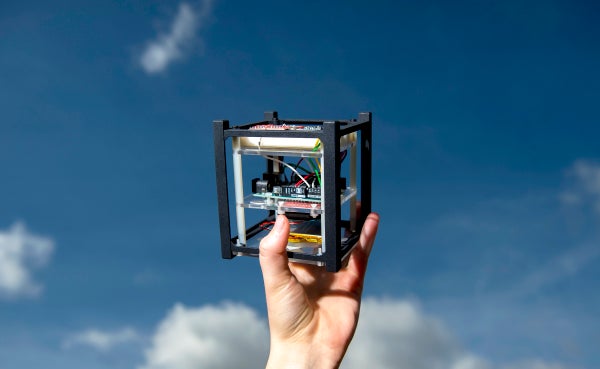Noah's Spaceship (original) (raw)
November 29, 2020
4 min read
A craft built to save Earth’s biodiversity from a planetary crisis would be far tinier—but vastly more far-reaching—than the biblical Ark

A tiny CubeSat could carry all of Earth's species into space in the form of their genomes.
There are many existential threats to life on Earth: a global pandemic even more deadly than COVID-19, a runaway greenhouse effect similar to what happened on Venus but with our own finger on the trigger; an impact by a giant asteroid bigger than the one that killed the dinosaurs; explosions of nearby stars in the form of supernovae or gamma-ray bursts; or the inevitable brightening of the sun within a billion years, which would boil all the oceans on Earth.
These catastrophes bring to mind the need to preserve the precious diversity of terrestrial life, in the spirit of the biblical story about Noah’s Ark. An exchange about these threats with a Harvard colleague, Stephen Greenblatt, inspired me to ponder what a modern Noah’s Ark might look like.
The rumination was reinvigorated by my participation in a televised debate on the question: “Is the space race good for humanity?” The other debaters were mostly concerned about the military risks from a space race between China and the U.S. But I argued that military threats are limited to the two-dimensional surface on which we live, whereas the exploration of space is mostly engaged with the third dimension, extending far away from the Earth’s surface. There would be no military threats to Earth as a result of settling on Mars or embarking on a trip to other stars, simply because these destinations are very distant.
On supporting science journalism
If you're enjoying this article, consider supporting our award-winning journalism by subscribing. By purchasing a subscription you are helping to ensure the future of impactful stories about the discoveries and ideas shaping our world today.
For example, a civilization on the nearest habitable exoplanet, Proxima Centauri b, will not know the upshot of the 2016 presidential elections until the beginning of February 2021, because radio signals take 4.244 years to get there at the speed of light. The current space race is driven by national pride and commercial interests in the same spirit that oceans were explored in the 15th and 16th centuries. If ships had been forbidden from leaving Europe for trade purposes just because of the military threat that navies might pose, the Americas would have never been colonized through a race between Portugal and Spain, followed by the Dutch Republic, England, France and Russia in the 17th and 18th centuries.
The only way to discover “new worlds” like the Americas is through the exploration of new territories, with associated risks. Space travel extends beyond the boundaries of nations. It is financially driven by the global economy, aiming to improve communication and navigation, to monitor weather patterns and climate change, to settle on the moon or Mars, to tour space, to mine asteroids, to deflect Earth-crossing objects and to remove artificial space debris. Free competition among commercial sector players, like SpaceX or Blue Origin, would only benefit humanity in the long term.
A colleague from Cambridge University, Jeremy Butterfield, reacted to the debate prompt with implicit irony: “Good question.... I’m very focused on merely terrestrial matters, for obvious reasons,” to which I replied: “In the long run, we will all have to leave Earth because it will not be habitable.” There is no doubt in my mind that space is our ultimate destiny because conditions will inevitably deteriorate on Earth. This was one of those rare circumstances under which an astronomer might end up sounding more pragmatic in the long run than a down-to-Earth advocate. Is there anything more practical and urgent than Noah’s ambition of saving life from extinction?
Currently, all our “eggs” are in one basket: Earth. A future incarnation of Noah’s Ark would lift off the surface of the Earth and sail into space. The biblical story details an Ark with dimensions of 150 by 25 by 15 meters on a side—coincidentally similar (but with no meaningful relation) to the inferred scales of the first interstellar object detected in the solar system, `Oumuamua.
Noah’s spacecraft does not need to carry samples of all forms of terrestrial life. There is no reason to build a huge craft that will carry humans, elephants, whales, birds and so on. Thanks to modern science and technology, the craft could be small—a CubeSat containing an advanced computer system with artificial intelligence that stores the complete DNA information of all species on Earth and is supplemented by a 3-D printer that can manufacture the seeds of life when desired. This platform could park at a safe location that receives enough solar heat to keep it comfortably warm and contains the raw materials for the chemistry of life. As the sun expands in its final stages of life, the platform can maneuver to the proper habitable distance from it.
We already sent so-called “Golden Records” out into interstellar space on the Voyager probes launched in 1977. The records included sounds and images that portray the diversity of life and culture on Earth, as a “message in a bottle” to another intelligent civilization without knowing where such a civilization might b, or whether our message will ever be received. A more technologically sophisticated Ark would instead be able to lay our “eggs” in many baskets.
The interesting follow-up question is whether life on Earth started this way, in which case our historical roots began with another civilization that no archaeological dig on Earth could reveal. Instead, as descendants of directed panspermia from space, we could search for our ancestors only by engaging in space archaeology.